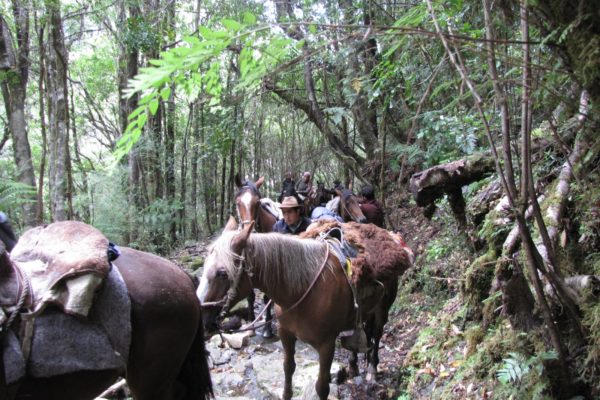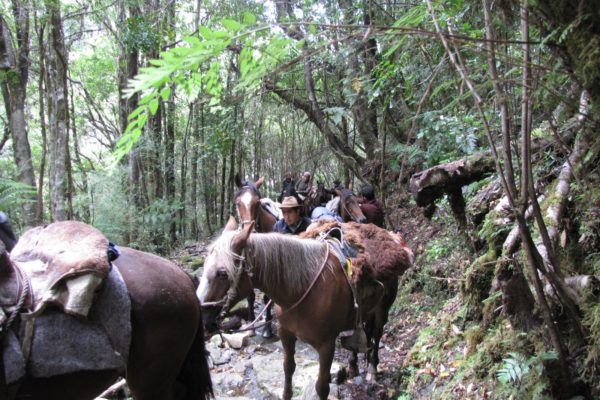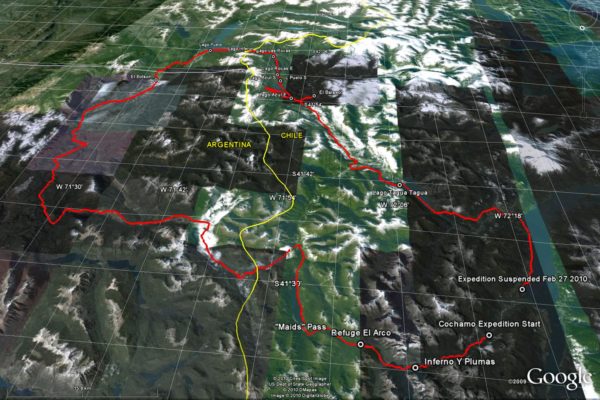This Alerce Field Study describes the findings from the exploration of the Cochamo Valley region of Chile undertaken to identify previously undocumented stands of the endangered Alerce tree (Fitzroya Cupressoides). The expedition was conducted between 15 February and 6 March, 2010 over an area 5,400 km2. Two Alerce stands were located and surveyed and two other sites were identified.
Project Goal
- Contribute to our understanding of Chile’s endangered temperate rainforests by exploring some of the more remote regions of the Valdivian Rainforest.
- Identify the locations and date previously undocumented Alerce (Fitzroya Cupressoides) trees in the Cochamo Valley of Chile.
- Confirm the existence and location of a particularly old Alerce rumored to exceed 20 meters in circumference.
Our Strategy
From a conservation perspective, Alerce are valuable because they are extremely slow growing (less than 1 millimeter a year) and thus are essentially non-renewable in our life-times. Alerce are useful for climate change measurement as like most trees, each year it forms a new layer of wood underneath the bark known as a “ring”. The size of these rings expands and contracts or ”surges” based on factors of temperature and rainfall. Due to their resistance to rot as well as the age that these trees can reach, Alerce are especially useful to climate researchers because they can be used in the development of long chronologies. (Holmes, 1985) Despite how little remains of these forests they are at risk of becoming extinct due to illegal poaching or are located in areas of interest for potential hydro-electric development. The World Conservation Union (IUCN) Conifer Specialist Group considers the Alerce endangered, and is facing a very high risk of extinction in the wild in the near future.
Chile’s varied geography contains at least ten distinct forest types including three regions of temperate rainforest: the Magellanic, the North Patagonia and the Valdivian which collectively cover 7.6 million hectares, roughly 25 percent of the Earth’s total. (Wilcox, 1996, p. 21). The Valdivian forest is named after Pedro de Valdivia, a founder of Chile and one of Francisco Pizarro’s Conquistadors who conquered the Incas.
Characteristics of a temperate rainforest include:
- Broadleaf evergreen flora
- More than 1,400 mm annual rainfall
- More than 10% of the total rain fall occurs in summer
- Mean temp. not more than 16° during the warmest month
- Frequently overcast conditions in summer
- Infrequent fires
- Winter dormancy in plants
(Alaback)
Within the Valdivian temperate rainforest, there exist at least seven distinct sub classifications of forest type. Of these, the Alerce forest represents one of the most endangered and ecologically valuable forest types in the world. The Alerce’s range at one time extended from the coastal mountains south of the city of Valdivia east to the wetter valleys on the Argentine side of the Andes and south to the slopes of the Michinmahido Volcano—a range of 150 miles long and 50 miles wide (Wilcox, 1996). However, early on the indigenous populations of Patagonia recognized the tree’s value as a building material and began logging the tree long before Spanish and then German immigrants migrated to the region, at which point, the speed of destruction increased exponentially.





